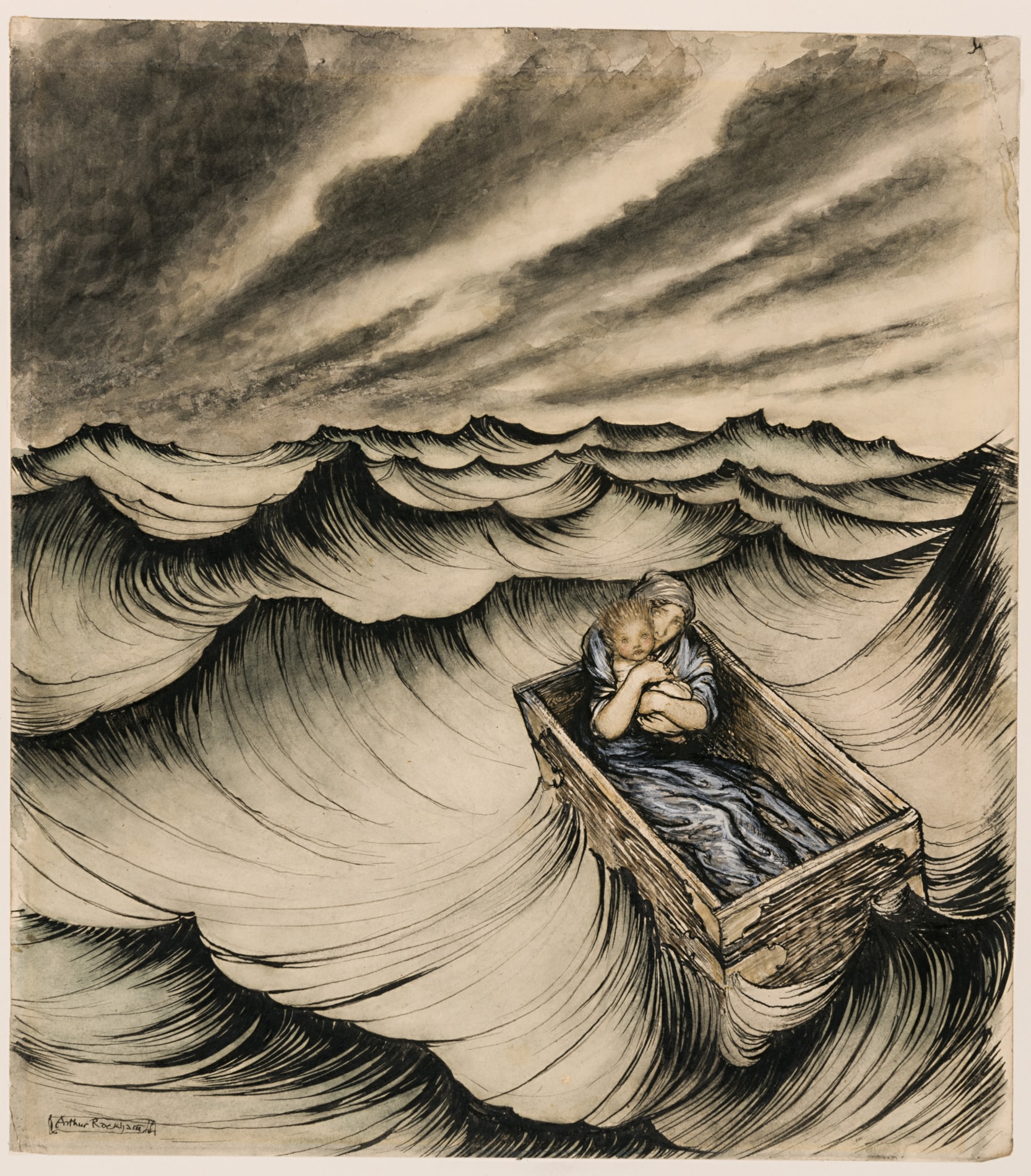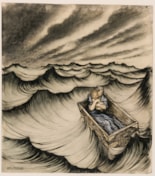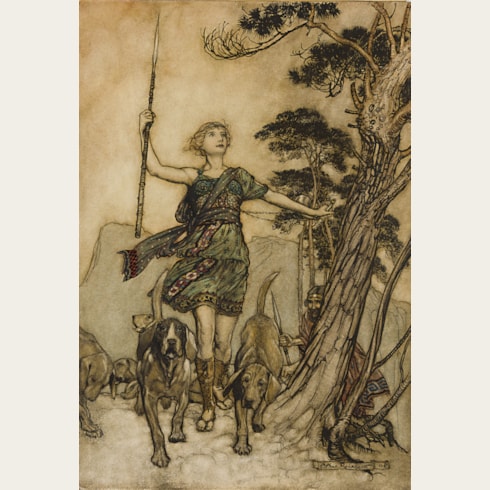Arthur RACKHAM
(Lewisham 1867 - Limpsfield 1939)
Danaë and the Infant Perseus: An Illustration for Nathaniel Hawthorne’s A Wonder-Book for Girls & Boys
Sold
Pen and black ink and black wash, with touches of watercolour, on paper laid down on card.
Signed Arthur Rackham at the lower left.
258 x 227 mm. (10 1/8 x 9 in.)
Signed Arthur Rackham at the lower left.
258 x 227 mm. (10 1/8 x 9 in.)
The present sheet was drawn for an illustrated edition of the American writer Nathaniel Hawthorne’s A Wonder-Book for Girls and Boys, published by Hodder & Stoughton in 1922 with sixteen illustrations by Arthur Rackham. The book, a retelling of Greek myths for children, had first appeared in print in 1851.
In Greek mythology, Danaë was the daughter of Acrisius, the King of Argos. Told by an oracle that his daughter would one day give birth to a son who would someday kill him, Acrisius locked his childless only daughter in a tower, in an attempt to foil the prophecy. Nevertheless, the god Zeus contrived to visit Danaë in her cell in the form of a shower of gold, resulting in her giving birth to a boy, Perseus. Acrisius placed his daughter and tiny grandson into a wooden box and threw it into the sea, trusting that they would be unable to survive the elements. As Hawthorne tells the story: ‘Perseus was the son of Danaë, who was the daughter of a king. And when Perseus was a very little boy, some wicked people put his mother and himself into a chest, and set them afloat upon the sea. The wind blew freshly, and drove the chest away from the shore, and the uneasy billows tossed it up and down; while Danaë clasped her child closely to her bosom, and dreaded that some big wave would dash its foamy crest over them both.’ However, the box came ashore on the island of Seriphos, and mother and son were rescued. Many years later, the oracle was proved correct when Acrisius was watching a sports competition, in which, unbeknownst to him, Perseus was competing. Perseus, who in turn did not know that his grandfather was in the audience, accidentally killed the old man with an errant discus throw.
One writer on Rackham has noted that ‘There is a gentle, almost imperceptible, softening of style in Rackham’s working during the early twenties. Rackham is mellowing, his love for the fantastic giving place to a love for what we so readily call ‘the real’. We see this…especially in Hawthorne’s A Wonder Book…the softening is noticeable in the manner in which he paints his children and women…The moment one opens Hawthorne’s Wonder Bookone becomes aware of the rounding and softening of form in Rackham’s work.’ The artist seems to have been especially pleased with his work for Hawthorne’s A Wonder-Book for Girls and Boys. As Rodney Engen has noted, ‘Rackham much admired this particular book; in later years on a working visit to the Unites States he was able to re-negotiate the book’s continued publication there with the American publisher George Doran.’
Another original ink and watercolour drawing by Rackham for the 1922 edition of the Wonder-Book, used for the endpapers of the book, is today in the British Museum. Other finished drawings for illustrations in the Wonder-Book, all in pen and ink and watercolour, are in the collections of the Rare Book and Manuscript Library at Columbia University in New York and the Free Library of Philadelphia, as well as in several private collections.
The present sheet is, in fact, the second finished version of this subject by Rackham, following a different composition drawn in 1903 and published ten years later in Arthur Rackham’s Book of Pictures, a compendium of mostly unpublished drawings. In the earlier drawing, in which the waves are much less prominent, the child Perseus is nestled into his mother’s chest, and his face is not seen. The 1903 drawing was in turn derived from a black and white line drawing by Rackham for Bartold Georg Nuebuhr’s book The Greek Heroes, published in 1903.
The provenance of this drawing can be traced back to Scott & Fowles of 667 Fifth Avenue, New York, who were Arthur Rackham's American gallery representatives throughout the 1920s. The gallery mounted four exhibitions of Rackham’s drawings between 1919 and 1927.
In Greek mythology, Danaë was the daughter of Acrisius, the King of Argos. Told by an oracle that his daughter would one day give birth to a son who would someday kill him, Acrisius locked his childless only daughter in a tower, in an attempt to foil the prophecy. Nevertheless, the god Zeus contrived to visit Danaë in her cell in the form of a shower of gold, resulting in her giving birth to a boy, Perseus. Acrisius placed his daughter and tiny grandson into a wooden box and threw it into the sea, trusting that they would be unable to survive the elements. As Hawthorne tells the story: ‘Perseus was the son of Danaë, who was the daughter of a king. And when Perseus was a very little boy, some wicked people put his mother and himself into a chest, and set them afloat upon the sea. The wind blew freshly, and drove the chest away from the shore, and the uneasy billows tossed it up and down; while Danaë clasped her child closely to her bosom, and dreaded that some big wave would dash its foamy crest over them both.’ However, the box came ashore on the island of Seriphos, and mother and son were rescued. Many years later, the oracle was proved correct when Acrisius was watching a sports competition, in which, unbeknownst to him, Perseus was competing. Perseus, who in turn did not know that his grandfather was in the audience, accidentally killed the old man with an errant discus throw.
One writer on Rackham has noted that ‘There is a gentle, almost imperceptible, softening of style in Rackham’s working during the early twenties. Rackham is mellowing, his love for the fantastic giving place to a love for what we so readily call ‘the real’. We see this…especially in Hawthorne’s A Wonder Book…the softening is noticeable in the manner in which he paints his children and women…The moment one opens Hawthorne’s Wonder Bookone becomes aware of the rounding and softening of form in Rackham’s work.’ The artist seems to have been especially pleased with his work for Hawthorne’s A Wonder-Book for Girls and Boys. As Rodney Engen has noted, ‘Rackham much admired this particular book; in later years on a working visit to the Unites States he was able to re-negotiate the book’s continued publication there with the American publisher George Doran.’
Another original ink and watercolour drawing by Rackham for the 1922 edition of the Wonder-Book, used for the endpapers of the book, is today in the British Museum. Other finished drawings for illustrations in the Wonder-Book, all in pen and ink and watercolour, are in the collections of the Rare Book and Manuscript Library at Columbia University in New York and the Free Library of Philadelphia, as well as in several private collections.
The present sheet is, in fact, the second finished version of this subject by Rackham, following a different composition drawn in 1903 and published ten years later in Arthur Rackham’s Book of Pictures, a compendium of mostly unpublished drawings. In the earlier drawing, in which the waves are much less prominent, the child Perseus is nestled into his mother’s chest, and his face is not seen. The 1903 drawing was in turn derived from a black and white line drawing by Rackham for Bartold Georg Nuebuhr’s book The Greek Heroes, published in 1903.
The provenance of this drawing can be traced back to Scott & Fowles of 667 Fifth Avenue, New York, who were Arthur Rackham's American gallery representatives throughout the 1920s. The gallery mounted four exhibitions of Rackham’s drawings between 1919 and 1927.
One of the famous and best-loved illustrators of his day, with a successful career which lasted for over forty years, Arthur Rackham provided illustrations for around 150 books and produced some 3,000 watercolours and drawings. He drew from a very early age, and soon after enrolling in evening classes at the Lambeth School of Art in 1884 began contributing illustrations to various newspapers and illustrated magazines such as The Westminster Budget and the Pall Mall Budget. His first real success, however, came with his illustrations for an edition of Grimm’s Fairy Tales, published in 1900, which led to many further projects, including editions of Peter Pan, Gulliver's Travels, Rip Van Winkle, A Midsummer Night's Dream and Andersen's Fairy Tales. Rackham’s superb technique and imaginative compositions were greatly admired, and his reputation as an illustrator, particularly of children’s books and fairy tales, was second to none. He exhibited his watercolours at both the Royal Academy and the Royal Society of Painters in Water-Colours, and won medals at exhibitions in Milan in 1906 and Barcelona in 1911. He also showed his drawings yearly at the Leicester Galleries in London, between 1906 and 1913.
In 1912 Rackham was honoured with a retrospective exhibition at the Societé Nationale des Beaux-Arts in Paris, and in 1919 was named a Master of the Art Workers Guild. By the 1920s Rackham’s work had become extremely popular in America, and he began to sell his original drawings through the Scott & Fowles gallery in New York, as well as receiving commission for advertising images. He only paid one visit to America, however, in 1927. In the 1930s his new publisher, George Harrap, began producing books made with less expensive paper and with the illustrations printed and bound with the text rather than tipped-in separately. Rackham’s last commission, from an American publisher, was for sixteen illustrations for an edition of Kenneth Grahame’s The Wind in the Willows, published in 1940, after the artist’s death.
Rackham’s draughtsmanship was praised by his contemporaries, who elected him to the Royal Society of Painters in Water-Colours on his first application, as well as by art critics, one of whom wrote in 1906 that ‘His admirable originality and exquisite technical skill have, within the last few years, gained him an assured place in the front rank of our water-colourists and draughtsmen; and to this place he has come not by fortunate accident, nor by the influence of powerful patrons, but solely by his own exertions...As a craftsman he has an extraordinary command over refinements of expression, a perfection of touch and a delicacy of hand which give rare distinction to everything he produces, and which, nevertheless, do not prevent him from attaining, when his subject requires it, the most satisfying vigour and decision. But in addition to this executive skill he has a faculty for seizing immediately upon the imaginative possibilities of the material he is considering.’
In 1912 Rackham was honoured with a retrospective exhibition at the Societé Nationale des Beaux-Arts in Paris, and in 1919 was named a Master of the Art Workers Guild. By the 1920s Rackham’s work had become extremely popular in America, and he began to sell his original drawings through the Scott & Fowles gallery in New York, as well as receiving commission for advertising images. He only paid one visit to America, however, in 1927. In the 1930s his new publisher, George Harrap, began producing books made with less expensive paper and with the illustrations printed and bound with the text rather than tipped-in separately. Rackham’s last commission, from an American publisher, was for sixteen illustrations for an edition of Kenneth Grahame’s The Wind in the Willows, published in 1940, after the artist’s death.
Rackham’s draughtsmanship was praised by his contemporaries, who elected him to the Royal Society of Painters in Water-Colours on his first application, as well as by art critics, one of whom wrote in 1906 that ‘His admirable originality and exquisite technical skill have, within the last few years, gained him an assured place in the front rank of our water-colourists and draughtsmen; and to this place he has come not by fortunate accident, nor by the influence of powerful patrons, but solely by his own exertions...As a craftsman he has an extraordinary command over refinements of expression, a perfection of touch and a delicacy of hand which give rare distinction to everything he produces, and which, nevertheless, do not prevent him from attaining, when his subject requires it, the most satisfying vigour and decision. But in addition to this executive skill he has a faculty for seizing immediately upon the imaginative possibilities of the material he is considering.’
Provenance
Scott & Fowles, New York
Art market, London
Private collection.
Art market, London
Private collection.
Literature
Nathaniel Hawthorne, A Wonder-Book for Girls & Boys, London, 1922; Nathaniel Hawthorne, A Wonder Book, Illustrated by Arthur Rackham, Alcester, 2013, reproduced on the cover.





